
Dec . 20, 2024 19:00 Back to list
uses of hydroxypropyl methylcellulose
The Uses of Hydroxypropyl Methylcellulose A Versatile Compound
Hydroxypropyl methylcellulose (HPMC) is a cellulose derivative that has gained significant attention for its diverse applications across various industries. This non-ionic polymer is synthesized from cellulose, a natural polymer obtained from plant cell walls, by substituting hydroxyl groups with hydroxypropyl and methoxy groups. HPMC's unique physical and chemical properties, such as thickening, gelling, and film-forming abilities, make it an invaluable ingredient in many products.
The Uses of Hydroxypropyl Methylcellulose A Versatile Compound
In the realm of construction, HPMC serves as a crucial additive in cement-based materials, such as mortars and plasters. Its water-retaining properties enhance the workability and adhesion of these materials, which ultimately leads to improved mechanical strength and durability in construction projects. Additionally, HPMC helps to prevent cracking and shrinkage during the drying process, making it an essential component for achieving high-quality construction results.
uses of hydroxypropyl methylcellulose

The food industry also benefits from the multifunctional properties of HPMC. It acts as a thickening and stabilizing agent in various food products, providing desirable textures and consistencies while improving shelf life. HPMC is often used in gluten-free baked goods, where it aids in moisture retention and enhances the overall quality of the finished product. In addition, it can serve as a fat replacer in reduced-fat or low-calorie formulations, offering the creamy mouthfeel that consumers desire without adding extra calories.
Another significant application of HPMC is in the personal care and cosmetics industry. Its film-forming ability makes it an effective ingredient in hair care products, providing hold and body to styling formulations. In skincare products, HPMC acts as a moisturizer and emulsifier, helping to stabilize emulsions and maintain product consistency. It is also widely used in various applications such as lotions, creams, and eye drops, contributing to the overall sensory experience and effectiveness of these products.
Furthermore, HPMC has found its way into the agricultural sector as well, where it is used as a soil conditioner and a binding agent in seed coatings. It improves water retention in soils and supports plant growth by promoting better seed germination and root development.
In conclusion, hydroxypropyl methylcellulose is a versatile compound with a wide range of applications spanning pharmaceuticals, construction, food, personal care, and agriculture. Its unique properties, such as thickening, gelling, and film-forming capabilities, make HPMC a valuable ingredient that enhances the quality and performance of various products. As research and development continue to explore new potential uses for HPMC, its importance in diverse industries is likely to expand, reaffirming its role as a key component in modern formulations.
-
Versatile Hpmc Uses in Different Industries
NewsJun.19,2025
-
Redispersible Powder's Role in Enhancing Durability of Construction Products
NewsJun.19,2025
-
Hydroxyethyl Cellulose Applications Driving Green Industrial Processes
NewsJun.19,2025
-
Exploring Different Redispersible Polymer Powder
NewsJun.19,2025
-
Choosing the Right Mortar Bonding Agent
NewsJun.19,2025
-
Applications and Significance of China Hpmc in Modern Industries
NewsJun.19,2025







